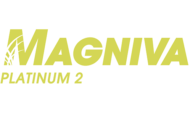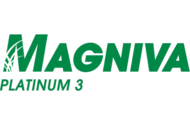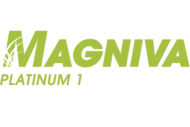As ensiled forage can make up 50 percent of the DMI in dairy cow diets, the attention to their quality has a tremendous impact on the profitability of the system. Indeed, whether concentrates used to balance the diet are at high or low prices, the forage represents, in most cases, the cheapest feed given to cows.
Producing best-quality silage requires basic management steps to be taken at every stage from crop management, harvesting, silo management ensuring a quick and controlled fermentation occurs. However, every producer is likely to face some adverse conditions during the development of the crop in the field that will eventually affect the capacity of this crop’s ability to produce high-quality silage.
Drought conditions before reaching the ideal maturity stage
The impact of a drought during the development of the maize affects the evolution of the physiological characteristics of the plant. Indeed, when maize goes through a severe drought, the leaves may get burnt and die off, which reduces photosynthesis, stalling what we could compare to as the “heart” of the plant. With the heart of the plant not working anymore, all physiological compounds remain where they are until the plant dies completely. During the drought of 2012 in the central part of the USA, 1,400 normal to drought conditioned maize silages were analyzed, giving tremendous differences of “ensiling” patterns due to completely different forage characteristics.
Maize silage analysis (1,386 samples, 1º. Jul – 7 Aug, 2012 (Dairyland Labs))
| DM | CP | NDF | ADF | NDF-D | Ash | Starch | Sugars | |
|---|---|---|---|---|---|---|---|---|
| Drought condition | 25.2 | 10.1 | 53.7 | 31.1 | 59.0 | 6.3 | 10.5 | 7.0 |
| Normal condition | 35.1 | 8.8 | 45.0 | 28.1 | 55.0 | 4.3 | 32.0 | 1.0 |
The Dry matter (DM) in drought conditions is much lower, explained by the reduction in photosynthesis which stops the transfer of nutrients and water through the veins of the plant. This is also why crude protein (CP) remains higher, the dilution effect with advancing maturity stages does not occur. One of the most important parameters discovered is the ratio of Starch/Sugar. During drought, sugars are no longer converted into starch, lowering the potential energetic value of the harvest, but also elevating residual sugar content after the fermentation stage (the acidification of forage uses a certain quantity of sugars, residual sugars remain free) that can be further degraded during the secondary fermentation at the opening of the silo.
If the initial high-sugar content is positive in promoting good acidification, the low DM and high nitrate contents may negatively impact the rate of fermentation by raising buffering capacity of the forage, the higher the buffering capacity the more difficult it is to lower pH and preserve the forage. The 2012 data also revealed much higher concentrations of nitrates measured in the silages after fermentation, the FDA gives the following recommendations for use in cattle nutrition.
Recommendations for use
| Nitrates-N (ppm) | Recommendations |
|---|---|
| < 1,000 | Safe |
| 1,000 to 2,000 | Exclusion to pregnant animals |
| 2,000 to 3,400 | Limit to 50% of the DMI |
| 3,400 to 4,000 | Limit to 25% of the DMI |
| > 4,000 | Don’t use as a feed |
Percentage of samples and Nitrate concentration (ppm) in maize silage – 2,323 samples, 1st. Jul / 16 Aug, 2012, (Dairyland Labs)
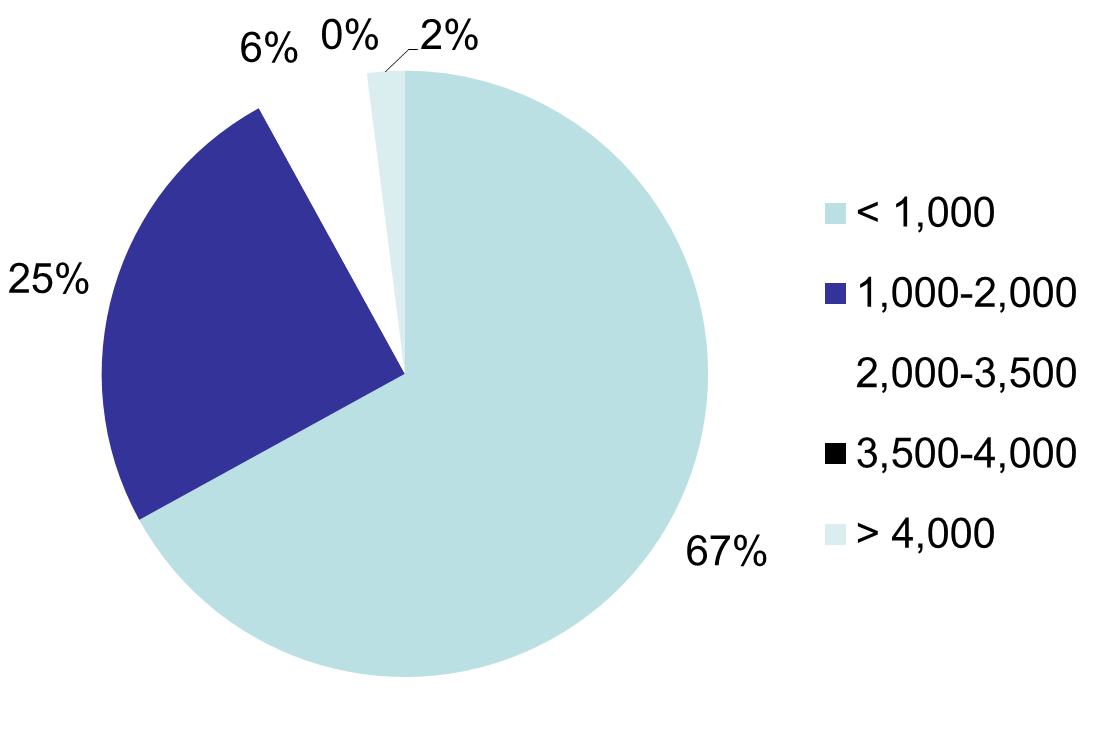
Sixty-seven percent of samples were analyzed as safe, 25% presented levels from 1,000 to 2,000 ppm that must be excluded to pregnant animals and 6 percent from 2,000 to 3,500 ppm must be limited at 50 percent of the DMI (from forage source).
With these results in mind, controlling each parameter of silage production from harvest to feedout is essential in ensuring the best-quality silage is produced allowing more flexibility over feed costs.
Producing high-quality maize silage under good conditions is usually straightforward, as the combination of the epiphytic flora, the amount of substrate for fermentation and the low buffering capacity of maize makes it easier to ensile quickly and efficiently. However, under drought conditions, the low DM conditions are more favorable to undesirable bacterial development such as enterobacteria and the high level of nitrates elevating the buffering capacity making the acidification process more challenging which can lead to excessive DM and nutrient losses. The use of condition-specific silage inoculant technology is essential when trying to produce silage under such conditions, this will help ensure the acidification process overcomes increased buffering, reducing DM losses and maintaining as much of the feed value of the crop as possible.
In addition, maize grown under stress is more prone to be infected by yeasts and fungal populations in the field. Further details from the 2012 analysis show from 183 silages more than 50 percent of them had yeast levels higher than 1,000,000cfu/g of forage, up to 10,000,000cfu/g.
Yeast contamination (n=183, Jul-Sept 2012, Dairyland Labs)
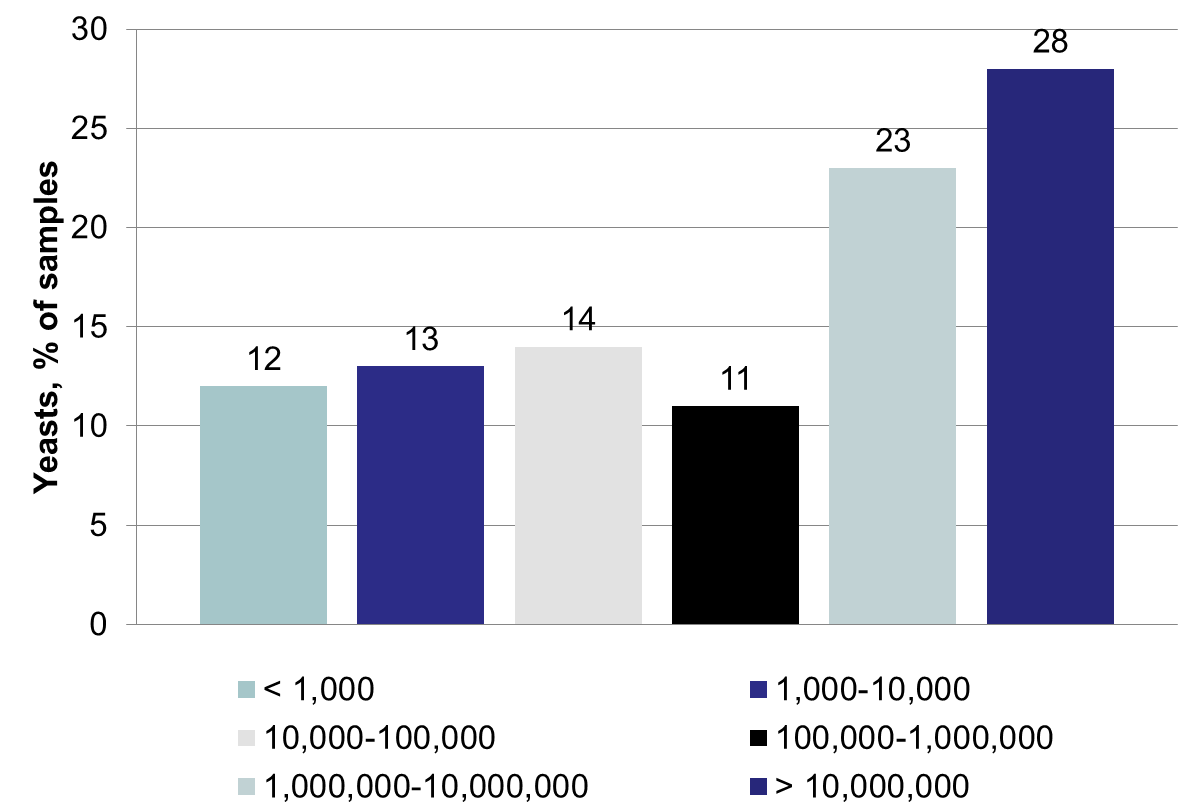
The concentration of yeast population in the silage is known to directly influence the risk of aerobic instability (silage heating and spoiling after opening). L.Kung, 2016, shown the decrease of aerobic stability related to the level of yeasts with a clear threshold of poor aerobic stability for yeast levels up to 4 log (10,000yeasts/g of silage).
Relationship between Numbers of Yeasts in Corn Silage and Aerobic Stability (L.Kung, 2016)

As drought-stressed crops are more likely to have high populations of yeast they are far more prone to be aerobically unstable when opened and can suffer significant DM losses through heating and wasted silage. Worse still, drought silages tend to have higher levels of residual sugars which may foster aerobic instability by driving the yeast growth. Excessive yeast levels also raise pH levels in the silage, yeast converts lactic acid into weaker acids, which allows a secondary undesirable fermentation where undesirable bacteria such enterobacteria, clostridia and fungi increase. This degrades the silage further by boosting DM losses, reducing the energy content and lowering digestibility and palatability.
Silage inoculants proven to inhibit the growth of yeast, molds and other undesirable bacteria are highly recommended when trying to produce silage from drought and weather-damaged crops. Inoculants containing the bacteria Lentilactobacillus buchneri 40788 and Lentilactobacillus hilgardii 4785 produce quantities acetic acid and other metabolites during the fermentation (acidification phase), which actively inhibit yeast, molds and other undesirable bacteria from growing. This results in silage of the best quality possible from less than perfect forage. The silage will be more aerobically stable with maintained feed value and reduced DM losses, meaning you have more of the original silage made for feedout.





